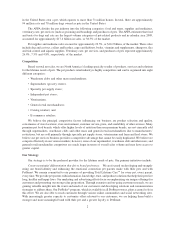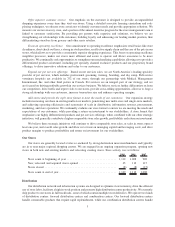Petsmart 2009 Annual Report Download - page 20
Download and view the complete annual report
Please find page 20 of the 2009 Petsmart annual report below. You can navigate through the pages in the report by either clicking on the pages listed below, or by using the keyword search tool below to find specific information within the annual report.addition, our proprietary branded products compete with other manufacturers’ branded items that we offer. As we
continue to evaluate the number and types of proprietary branded products that we sell, we may adversely affect our
relationships with our vendors, who may decide to reduce their product offerings through us and increase their
product offerings through our competitors. Finally, if any of our customers are harmed by our proprietary branded
products, they may bring product liability and other claims against us. Any of these circumstances could have an
adverse effect on our business and financial performance.
Food safety, quality and health concerns could affect our business.
We could be adversely affected if consumers lose confidence in the safety and quality of certain vendor-supplied
food products and hard-good products. Adverse publicity about these types of concerns, whether valid or not, may
discourage consumers from buying the products in our stores or cause vendor production and delivery disruptions. The
real or perceived sale of contaminated food products by us could result in product liability claims against our vendors
or us and a loss of consumer confidence, which could have an adverse effect on our sales and operations.
We depend on key executives, store managers and other personnel and may not be able to retain or replace
these employees or recruit additional qualified personnel, which could harm our business.
Our success is largely dependent on the efforts and abilities of our senior executive group and other key
personnel. The loss of the services of one or more of our key executives or personnel, or the increased demands
placed on our key executives and personnel by our continued growth, could adversely impact our financial
performance and our ability to execute our strategies. In addition, our future success depends on our ability to
attract, train, manage and retain highly skilled store managers and qualified services personnel such as pet trainers
and groomers. There is a high level of competition for these employees, and our ability to operate our stores and
expand our services depends on our ability to attract and retain these personnel. Competition for qualified
management and services personnel could require us to pay higher wages or other compensation to attract a
sufficient number of employees. Turnover, which has historically been high among entry-level or part-time
associates at our stores and distribution centers, increases the risk associates will not have the training and
experience needed to provide competitive, high-quality customer service. Our ability to meet our labor needs while
controlling our labor costs is subject to numerous external factors, including unemployment levels, prevailing wage
rates, changing demographics and changes in employment legislation. If we are unable to retain qualified associates
or our labor costs increase significantly, our business operations and our financial performance could be adversely
impacted. In addition, there historically has been a shortage of qualified veterinarians. If third party veterinary
services providers cannot attract and retain a sufficient number of qualified veterinarians, their ability to provide
veterinary services in our stores and our ability to increase the number of stores in which veterinary services are
provided, may be impacted.
Our international operations may result in additional market risks, which may harm our business.
We entered the Canadian market in 1996 and operate 63 stores in Canada as of January 31, 2010. As these
operations grow, they may require greater management and financial resources. International operations require the
integration of personnel with varying cultural and business backgrounds and an understanding of the relevant
differences in the cultural, legal, and regulatory environments. Our results may be increasingly affected by the risks
of our international activities, including:
• Fluctuations in currency exchange rates;
• Changes in international staffing and employment issues;
• Tariff and other trade barriers;
• Greater difficulty in utilizing and enforcing our intellectual property rights;
• Failure to understand the local culture and market;
• The burden of complying with foreign laws, including tax laws and financial accounting standards; and
• Political and economic instability and developments.
12
























